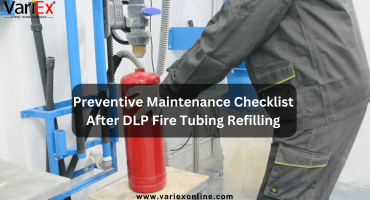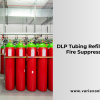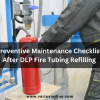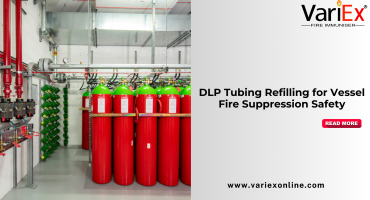![]()
Fire Immuniser
+91-7829629111
Email: info@variex.in
Varistor Technologies Pvt. Ltd.
Block-1, First Floor, Ardente Office One, Hoodi Circle, ITPL Main Road, Bengaluru, Karnataka 560048, IN
Automatic Fire Sprinkler System Installation
Automatic fire sprinkler systems are a crucial component of fire protection in buildings, providing a rapid response to suppress fires and minimize damage. Installation of these systems involves a meticulous process that integrates engineering principles, building codes, and safety standards. This informational content will outline the key aspects of automatic fire sprinkler system installation, emphasizing its importance in safeguarding lives and property.
1. Understanding Automatic Fire Sprinkler Systems:
- Automatic fire sprinkler systems consist of a network of pipes, valves, sprinkler heads, and a water supply.
- They are designed to detect and extinguish fires automatically, releasing water onto the affected area when heat from a fire activates the sprinkler heads.
- Various types of sprinkler systems exist, including wet pipe, dry pipe, pre-action, and deluge systems, each suitable for different environments and fire hazards.
2. Pre-Installation Planning:
- A comprehensive assessment of the building's layout, occupancy, and fire risks is conducted to determine the appropriate design for the sprinkler system.
- Collaboration between architects, engineers, fire protection specialists, and building owners ensures compliance with local building codes and fire safety regulations.
- Detailed drawings and hydraulic calculations are prepared to specify the location of sprinkler heads, pipe routes, water supply requirements, and hydraulic demand.
3. Installation Process:
- Installation begins with the placement of piping networks throughout the building, typically concealed within walls, ceilings, and floors.
- Sprinkler heads are strategically positioned based on the fire hazard classification of different areas within the building.
- Valves, alarms, pressure gauges, and other system components are installed according to the approved design plans.
- Highly skilled technicians carry out welding, threading, and jointing of pipes, ensuring tight seals and proper functioning of the system.
4. Water Supply Considerations:
- Adequate water supply is essential for the effective operation of fire sprinkler systems.
- Installation may involve connecting the system to municipal water supplies, on-site storage tanks, or dedicated fire pumps, depending on water availability and pressure requirements.
- Backup power sources such as generators are often integrated to ensure uninterrupted water flow during power outages.
5. Testing and Commissioning:
- Once installation is complete, rigorous testing and commissioning procedures are conducted to verify the functionality and reliability of the system.
- Flow tests, pressure tests, and functional tests are performed to ensure proper operation of valves, alarms, and sprinkler heads.
- System performance is evaluated under simulated fire conditions to validate its effectiveness in controlling and suppressing fires.
6. Ongoing Maintenance and Inspection:
- Regular maintenance and inspection are essential to keep the fire sprinkler system in optimal working condition.
- Scheduled inspections, conducted by qualified technicians, ensure that all components are free from corrosion, obstruction, or damage.
- Any deficiencies or malfunctions identified during inspections are promptly addressed to maintain the system's reliability and compliance with safety standards.
7. Design Considerations:
- Designing an effective fire sprinkler system involves assessing the occupancy type, occupancy load, building layout, and fire hazards present.
- Factors such as ceiling height, obstructions, and ventilation systems must be taken into account to ensure proper coverage and distribution of water.
- Advanced computer-aided design (CAD) software is often utilized to create detailed plans and hydraulic calculations, optimizing the system's performance.
8. Material Selection:
- The choice of materials for piping and sprinkler heads is crucial to the longevity and reliability of the system.
- Common materials include steel, copper, and CPVC (Chlorinated Polyvinyl Chloride), each offering different advantages in terms of cost, corrosion resistance, and ease of installation.
- Compatibility with water quality, temperature, and pressure conditions must also be considered when selecting materials.
9. Regulatory Compliance:
- Automatic fire sprinkler system installation must adhere to various building codes, standards, and regulations established by national and local authorities.
- Compliance with codes such as NFPA 13 (National Fire Protection Association) and local jurisdictional requirements ensures that the system meets minimum safety standards and performance criteria.
- Building permits and approvals are obtained prior to installation, with inspections conducted at various stages of the process to verify compliance.
10. Specialized Applications:
- In addition to standard commercial and residential buildings, automatic fire sprinkler systems are also installed in specialized environments such as industrial facilities, warehouses, high-rise buildings, and healthcare facilities.
- Specialized systems, such as foam-water sprinkler systems for high-hazard areas or oxygen reduction systems for sensitive environments, may be required to address specific fire risks.
11. Integration with Fire Alarm Systems:
- Integration with fire alarm systems enhances the overall effectiveness of fire protection measures.
- Fire sprinkler systems can be interfaced with fire detection systems to provide early warning and automatic activation in the event of a fire.
- Upon activation, sprinkler systems may also trigger audible and visual alarms to alert occupants and emergency responders.
12. Retrofitting Existing Buildings:
- Retrofitting automatic fire sprinkler systems into existing buildings poses unique challenges but is often necessary to enhance fire safety in older structures.
- Retrofit projects require careful consideration of building layout, structural modifications, and accessibility for installation.
- Innovative retrofit solutions, such as the use of flexible piping systems or retroactive installation of sprinkler heads, help overcome logistical constraints while minimizing disruption to building occupants.
Automatic fire sprinkler system installation is a multifaceted process that requires careful planning, engineering expertise, and adherence to regulatory requirements. From design and material selection to testing and maintenance, every aspect of the installation contributes to the system's reliability and effectiveness in protecting lives and property. By staying informed about the latest advancements in fire protection technology and best practices, stakeholders can ensure that their buildings are equipped with robust fire sprinkler systems capable of mitigating the devastating impact of fires.
Frequently Asked Questions
An automatic fire sprinkler system is a network of pipes, valves, and sprinkler heads installed in buildings to detect and suppress fires automatically. When heat from a fire activates a sprinkler head, water is released onto the fire to control its spread and minimize damage.
Automatic fire sprinkler systems are vital for protecting lives and property in the event of a fire. They provide rapid response, suppress fires quickly, reduce smoke and heat, and give occupants more time to evacuate safely. Additionally, they can prevent fires from spreading to adjacent areas, minimizing property damage.
Automatic fire sprinkler systems work by utilizing heat-activated sprinkler heads. When the ambient temperature around a sprinkler head reaches a predetermined level, typically between 135-165°F (57-74°C), a fusible element or glass bulb ruptures, allowing water to flow from the sprinkler head onto the fire below.
There are several types of automatic fire sprinkler systems, including:
- Wet pipe systems: Filled with water under pressure and are the most common type.
- Dry pipe systems: Filled with pressurized air or nitrogen, with water held back by a valve until a sprinkler head activates.
- Pre-action systems: Similar to dry pipe systems but require a separate activation signal before water flows into the piping.
- Deluge systems: All sprinkler heads are open and will release water simultaneously when activated.
Design considerations include building occupancy type, occupancy load, fire hazard classification, ceiling height, obstructions, water supply availability, and local building codes and regulations. Computer-aided design (CAD) software is often used to create detailed plans and hydraulic calculations.
Final Say
At VariEx.in and VariexOnline.com, we specialize in supplying and installing top-quality fire fighting systems and equipment. From fire extinguishers to advanced suppression systems, we offer comprehensive solutions tailored to your needs. Our experienced team ensures precise installation and maintenance for optimal safety.
Trust VariEx for reliable fire protection. Contact us online or call 7829629111 to learn more.
"WHAT YOU CAN READ NEXT"
 Read more +24 November 2023 in Fire Extinguisher
Read more +24 November 2023 in Fire ExtinguisherWhat types of fire extinguishers are available for different fire classes?
 Read more +11 July 2025 in Fire Suppression
Read more +11 July 2025 in Fire Suppression







